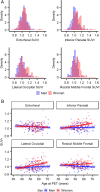Menopause Status Moderates Sex Differences in Tau Burden: A Framingham PET Study
- PMID: 35471588
- PMCID: PMC9233144
- DOI: 10.1002/ana.26382
Menopause Status Moderates Sex Differences in Tau Burden: A Framingham PET Study
Abstract
Objective: Women have a higher lifetime risk of Alzheimer's disease (AD) than men. Among cognitively normal (CN) older adults, women exhibit elevated tau positron emission tomography (PET) signal compared with men. We explored whether menopause exacerbates sex differences in tau deposition in middle-aged adults.
Methods: 328 CN participants from the Framingham Study (mean age = 57 years (±10 years), 161 women, of whom, 104 were post-menopausal) underwent tau and β-amyloid (Aβ)-PET neuroimaging. We examined global Aβ-PET, and tau-PET signal in 5 regions identified a priori as demonstrating significant sex differences in older adults (in temporal, inferior parietal, middle frontal, and lateral occipital regions). We examined sex and menopause status-related differences in each region-of-interest, using linear regressions, as well as interactions with Aβ and APOEε4 genotype.
Results: Women exhibited higher tau-PET signal (p < 0.002), and global Aβ-PET (p = 0.010), than men in inferior parietal, rostral middle frontal, and lateral occipital regions. Compared with age-matched men, post-menopausal women showed significantly higher tau-PET signal in parieto-occipital regions (p < 0.0001). By contrast, no differences in tau-PET signal existed between pre-menopausal women and men. Aβ-PET was not associated with menopausal status or age. Neither Aβ-PET nor APOEε4 status moderated sex or menopause associations with tau-PET.
Interpretation: Clear divergence in tauopathy between the sexes are apparent approximately 20 years earlier than previously reported. Menopause status moderated sex differences in Aβ and tau-PET burden, with tau first appearing post-menopause. Sex and menopause differences consistently appeared in middle frontal and parieto-occipital regions but were not moderated by Aβ burden or APOEε4, suggesting that menopause-related tau vulnerability may be independent of AD-related pathways. ANN NEUROL 2022;92:11-22.
© 2022 The Authors. Annals of Neurology published by Wiley Periodicals LLC on behalf of American Neurological Association.
Conflict of interest statement
Nothing to report.
Figures


References
-
- Farrer LA, Cupples L, Haines JL, et al. Effects of age, sex, and ethnicity on the association between apolipoprotein e genotype and alzheimer disease: a meta‐analysis. JAMA 1997;278:1349–1356. - PubMed
-
- Breitner JCS, Wyse BW, Anthony JC, et al. APOE‐ε4 count predicts age when prevalence of AD increases, then declines: the Cache County study. Neurology 1999;53:321. - PubMed
Publication types
MeSH terms
Substances
Grants and funding
- K24AG035007/AG/NIA NIH HHS/United States
- R01 NS017950/NS/NINDS NIH HHS/United States
- R01 AG054076/AG/NIA NIH HHS/United States
- AG049607/AG/NIA NIH HHS/United States
- U01 AG058589/AG/NIA NIH HHS/United States
- RF1 AG061872/AG/NIA NIH HHS/United States
- K24 AG035007/AG/NIA NIH HHS/United States
- RF1 AG059421/AG/NIA NIH HHS/United States
- R00 AG061238/AG/NIA NIH HHS/United States
- R01 AG049607/AG/NIA NIH HHS/United States
- R01 AG008122/AG/NIA NIH HHS/United States
- R00AG061238/AG/NIA NIH HHS/United States
- P30 AG066546/AG/NIA NIH HHS/United States
- R01 AG033040/AG/NIA NIH HHS/United States
- U01 AG052409/AG/NIA NIH HHS/United States
LinkOut - more resources
Full Text Sources
Medical

